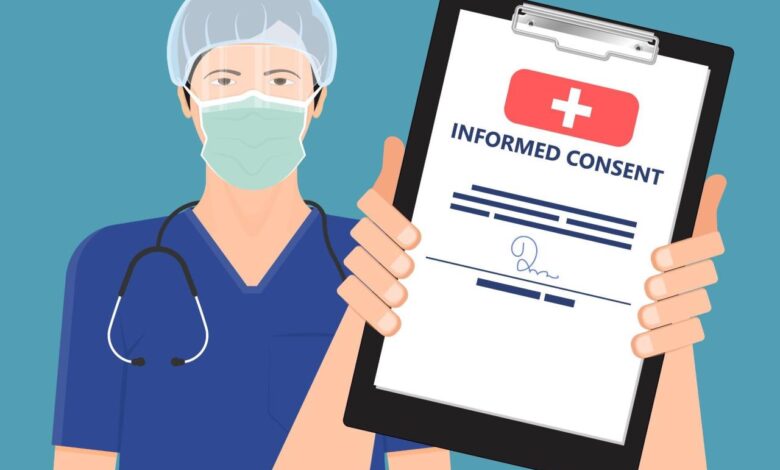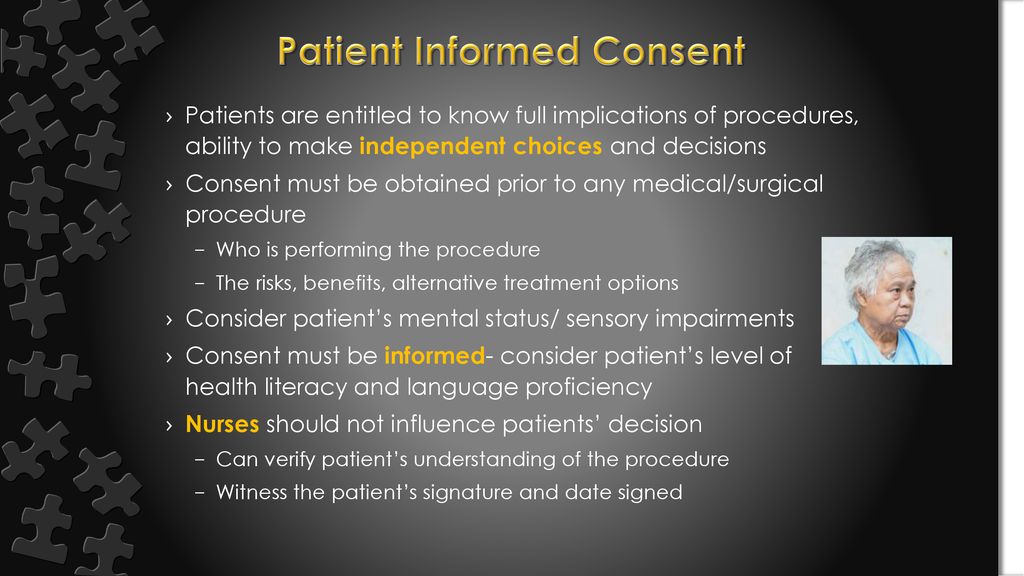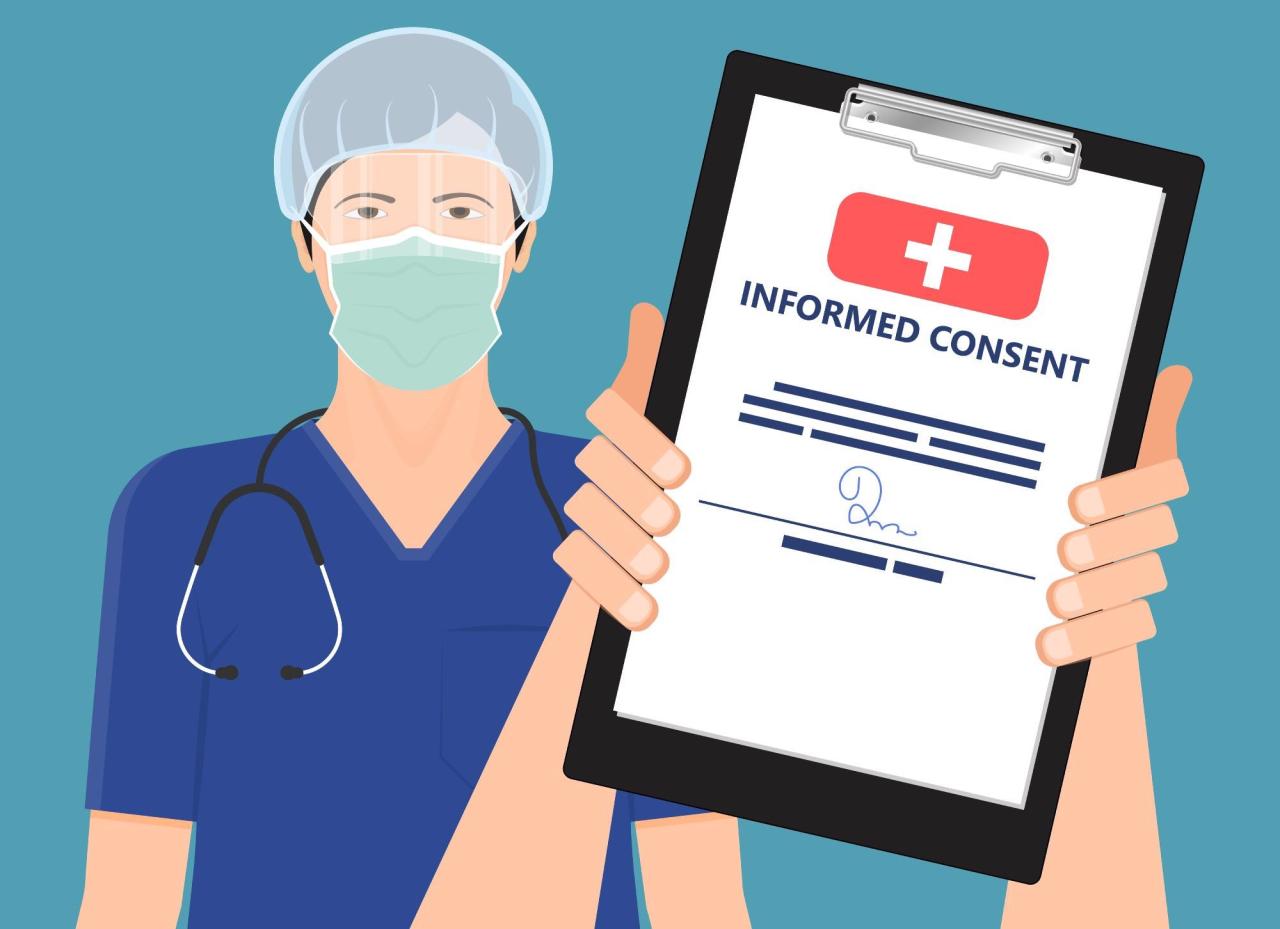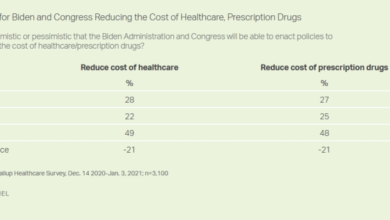
What is informed consent? It’s a crucial process in healthcare and research, ensuring patients have the information they need to make decisions about their own bodies and treatments. This overview delves into the historical context, legal frameworks, and practical applications of informed consent, examining its vital role in promoting patient autonomy and ethical practice. We’ll cover the different types of consent, the elements that make it valid, and how it’s applied in various medical settings.
From the basic definition to complex considerations like cultural sensitivity and language barriers, this comprehensive guide unravels the intricacies of informed consent. We’ll explore the components of disclosure, understanding, voluntariness, and competence, and discuss how these elements work together to guarantee truly informed choices. We’ll also look at common challenges and ethical dilemmas that arise, as well as how to ensure proper documentation and procedures in different scenarios.
Definition and Scope: What Is Informed Consent
Informed consent is a fundamental ethical and legal principle in healthcare, emphasizing patient autonomy and self-determination. It’s a process, not a single event, where patients are provided with sufficient information to make informed decisions about their care. This empowers individuals to actively participate in their health journey.The historical context of informed consent is rooted in the recognition of patient rights.
Early medical practices often lacked transparency and patient involvement. Landmark legal cases, such as the 1972 Canterbury v. Spence case in the US, helped solidify the concept of informed consent as a crucial element of patient care, highlighting the need for disclosure of relevant information.
Key Elements of Valid Informed Consent
Informed consent requires specific elements to be considered valid. These elements ensure patients understand the risks, benefits, and alternatives to a proposed procedure or treatment. Critical elements include:
- Disclosure of Information: The healthcare provider must provide sufficient information about the proposed procedure or treatment, including potential risks and benefits, alternatives, and expected outcomes. This disclosure should be tailored to the patient’s understanding and comprehension level.
- Understanding of Information: The patient must demonstrate an understanding of the disclosed information. This involves actively engaging with the provider to clarify any doubts or uncertainties. The healthcare provider must ensure the patient grasps the implications of the decision.
- Competence to Consent: The patient must possess the capacity to make a rational decision. This involves assessing the patient’s cognitive abilities and understanding of the situation. Individuals under legal guardianship or with diminished capacity may require specific arrangements for consent.
- Voluntariness: The patient’s decision must be made freely, without coercion or undue influence. The patient should not feel pressured or manipulated into accepting a specific treatment or procedure.
Relationship Between Informed Consent and Autonomy
Informed consent is inextricably linked to patient autonomy. Autonomy emphasizes the right of individuals to make decisions about their own bodies and health care. By providing comprehensive information, healthcare providers respect the patient’s right to self-determination and empower them to choose a course of action that aligns with their values and preferences.
Informed Consent in Different Healthcare Settings
The application of informed consent varies between healthcare settings.
- Clinical Practice: In clinical practice, informed consent focuses on procedures and treatments aimed at improving or maintaining the patient’s health. This often involves detailed discussions about potential complications and alternative approaches.
- Research: In research settings, informed consent is crucial to protect the rights and well-being of research participants. The disclosure must include the purpose of the research, potential risks and benefits, and procedures for data privacy and confidentiality. The need for additional safeguards, such as independent review boards, underscores the unique nature of research consent.
Types of Informed Consent
Different types of informed consent cater to various circumstances.
- Written Consent: Written consent provides a tangible record of the agreement between the patient and the healthcare provider. It’s essential for procedures requiring detailed explanation and documentation.
- Verbal Consent: Verbal consent can be appropriate for minor procedures or situations where a written document isn’t practical or necessary. However, it’s essential to maintain a clear record of the agreement.
Legal Requirements for Informed Consent
The legal requirements for informed consent vary across jurisdictions.
| Jurisdiction | Key Legal Requirements |
|---|---|
| USA | Specific standards exist within each state. Common requirements include disclosure of material risks, understanding of information, and voluntary decision-making. |
| UK | The UK adheres to common law principles, focusing on the duty of care and the need to disclose material risks to the patient. |
| EU | The EU emphasizes patient rights and autonomy. Specific regulations may vary across member states, but general principles regarding information disclosure and patient comprehension are paramount. |
Components of Informed Consent

Informed consent is a cornerstone of ethical medical and research practices. It’s more than just a signature; it’s a process that ensures patients and participants are empowered to make autonomous decisions about their health and well-being. This process hinges on clear communication and mutual understanding between the provider and the individual.
Disclosure
Adequate disclosure is crucial for informed consent. It involves providing patients with comprehensive information about the proposed procedure, treatment, or research study. This information must be presented in a clear, understandable, and accessible manner. It should cover potential benefits, risks, and alternatives. Furthermore, patients should be informed of the implications of refusing the proposed course of action.
Failing to adequately disclose relevant information can invalidate the consent.
Key elements of disclosure include:
- Nature of the procedure or intervention.
- Potential risks and benefits.
- Reasonable alternatives, including no intervention.
- Expected outcomes and possible complications.
- Name and qualifications of the healthcare provider or researcher.
Understanding
Understanding the information disclosed is a critical component of informed consent. The individual must comprehend the nature, purpose, and implications of the proposed intervention. This requires clear and concise communication tailored to the individual’s level of understanding. Consideration should be given to any potential language or cultural barriers.
Factors affecting understanding include:
- Patient’s health literacy.
- Complexity of the medical procedure.
- Clarity of the communication.
- Presence of language or cultural barriers.
- Patient’s emotional state and cognitive capacity.
Voluntariness
Voluntariness ensures that the individual’s decision to consent is truly free and uncoerced. Any form of pressure, undue influence, or manipulation invalidates the consent. This includes situations where the patient feels pressured by the healthcare provider’s authority or perceived social expectations. The patient should feel empowered to decline without fear of reprisal.
Examples of situations that could compromise voluntariness include:
- Threats or promises of rewards.
- Explicit or implicit coercion.
- Exploitation of vulnerabilities.
- Unequal power dynamics between the patient and provider.
Competence
Competence in the context of informed consent refers to the individual’s capacity to understand the information provided and make a rational decision. It encompasses the ability to communicate choices, appreciate the situation, and understand the consequences of their decisions. This is not a fixed attribute; it can fluctuate based on the individual’s mental state and condition.
Factors influencing competence include:
- Cognitive ability.
- Mental health status.
- Level of consciousness.
- Age and developmental stage.
- Substance use or withdrawal.
Barriers to Informed Consent
Several factors can hinder the informed consent process. These include communication barriers, cultural differences, and cognitive limitations.
Potential barriers to informed consent include:
- Language barriers.
- Cultural differences in decision-making.
- Cognitive impairments.
- Emotional distress.
- Lack of time or access to information.
Waiver or Alteration of Informed Consent
In specific situations, informed consent may be waived or altered. This is often governed by legal and ethical guidelines, and must be justified. Examples include emergencies, situations where obtaining consent is impractical, or when a patient lacks the capacity to consent.
Informed consent is all about understanding the risks and benefits of a decision before you make it. It’s crucial for making choices about your health, like whether or not to undergo a particular treatment. Considering the potential consequences of policies like those explored in the article on can you tax people into quitting smoking , which delve into the effectiveness of incentivizing behavior change, highlights the complex interplay of personal autonomy and public health initiatives.
Ultimately, informed consent boils down to being fully aware of the options and their implications before committing.
Examples of situations where informed consent may be waived include:
- Emergency situations.
- Situations where obtaining consent is impractical.
- Situations where the patient lacks the capacity to consent.
- Research studies with minimal risk.
Common Pitfalls in Obtaining Informed Consent
| Pitfall | Description |
|---|---|
| Incomplete Disclosure | Failure to provide all necessary information. |
| Lack of Clarity | Information presented in a confusing or unclear manner. |
| Inadequate Understanding | Insufficient assessment of the patient’s comprehension. |
| Coercion or Undue Influence | Patient feeling pressured into making a decision. |
| Failure to Document | Lack of proper documentation of the consent process. |
Application in Different Contexts
Informed consent isn’t a one-size-fits-all concept. Its application varies significantly depending on the context, from research studies to clinical procedures and even interactions with vulnerable populations. Understanding these nuances is crucial for ensuring ethical and legally sound practices. This section delves into the multifaceted application of informed consent across different settings.The application of informed consent is not static; it adapts to the specific needs and circumstances of each situation.
Informed consent is all about understanding the risks and benefits of a decision before you agree to it. It’s crucial for making choices about your health, and that includes things like choosing the right contraception. For example, when considering different types of birth control, like condoms, understanding the fit and potential impact on comfort and effectiveness is part of the informed consent process.
Knowing if different sizes of condoms exist and whether they’re necessary for optimal use is vital for informed consent in sexual health decisions. This crucial information can be found in resources like do we need different sizes of condoms. Ultimately, informed consent ensures you’re making well-informed decisions about your body and your health.
This adaptability is essential to protect individuals while still allowing for advancements in research and improvements in healthcare. A critical understanding of informed consent is vital in each context to guarantee both the participant’s rights and the integrity of the process.
Informed Consent in Research Involving Human Subjects
Research involving human subjects requires meticulous adherence to informed consent principles. Researchers must provide comprehensive information about the study’s purpose, procedures, potential risks and benefits, and participant rights. This includes explaining the voluntary nature of participation and the option to withdraw at any time without penalty. Detailed documentation of the informed consent process is crucial for ethical review and accountability.
Researchers must also ensure the consent form is comprehensible to the participant.
Application of Informed Consent in Clinical Practice
In clinical practice, informed consent is the cornerstone of patient autonomy. Physicians must provide patients with clear explanations of proposed treatments, including potential risks, benefits, alternatives, and the patient’s right to refuse. The discussion should encompass the specific details of the procedure, expected outcomes, and possible complications. This proactive communication fosters trust and shared decision-making. A crucial aspect is to tailor the explanation to the patient’s understanding and medical literacy.
Unique Challenges of Informed Consent for Vulnerable Populations
Vulnerable populations, such as children, individuals with cognitive impairments, and those with limited literacy, pose unique challenges to the informed consent process. For children, the consent must be obtained from a legal guardian or parent, who should be adequately informed about the study or procedure. For individuals with cognitive impairments, simplified language, visual aids, and support from advocates are necessary to ensure true understanding.
Consent must be adapted to the individual’s specific cognitive capacity and the procedure’s complexity.
Examples of Informed Consent Forms for Different Procedures
Different procedures require varying levels of detail in informed consent forms. A consent form for a simple blood draw would be significantly shorter than one for a complex surgical procedure. Each form must clearly Artikel the specific procedure, potential risks, and benefits. Examples include:
- Surgical Procedures: These forms detail the surgical procedure, potential complications, recovery period, and alternative treatment options. They also include contact information for the surgeon and hospital.
- Medical Research: These forms Artikel the research study’s purpose, procedures, potential risks, and benefits. They highlight the voluntary nature of participation and the participant’s right to withdraw at any time.
- Blood Donation: These forms emphasize the procedure’s safety, potential risks (rare), and benefits (helping others). They also explain the donation process and any restrictions.
Scenarios Where Informed Consent is Crucial
Informed consent is vital in numerous scenarios, including:
- New medical treatments: Patients must understand the potential risks and benefits of new and experimental treatments before agreeing to participate.
- Research studies: Participants need to comprehend the study’s purpose, procedures, potential risks, and benefits before agreeing to participate.
- Surgical procedures: Patients need to understand the surgical procedure, potential complications, recovery period, and alternative treatments before agreeing to undergo the procedure.
Ethical Considerations Associated with Informed Consent
Ethical considerations in informed consent include:
- Respect for autonomy: The process must respect the patient’s right to make their own decisions.
- Competence: The patient must have the capacity to understand the information and make a decision.
- Disclosure: All relevant information must be disclosed to the patient in a comprehensible manner.
- Voluntariness: The patient’s decision must be free from coercion or undue influence.
Contrasting Application of Informed Consent in Various Medical Specialties
| Medical Specialty | Key Considerations in Informed Consent |
|---|---|
| Surgery | Detailed explanation of procedure, potential complications, recovery, and alternative options. |
| Oncology | Discussion of treatment options, potential side effects, prognosis, and quality of life. |
| Cardiology | Explanation of diagnostic tests, treatment options, and potential risks. |
| Psychiatry | Addressing patient’s mental state, potential treatment side effects, and long-term implications. |
Documentation and Procedures
Informed consent is more than just a signature; it’s a crucial process that needs meticulous documentation and adherence to legal standards. Proper documentation ensures the validity of the consent and protects both the patient and the healthcare provider. This section dives into the specifics of documenting informed consent, outlining legal requirements, different methods for obtaining consent, and addressing patient inquiries.The documentation of informed consent is paramount in ensuring legal compliance and maintaining patient trust.
It serves as a verifiable record of the patient’s agreement to a procedure or treatment, outlining the details of the procedure, potential risks, benefits, and alternative options. This record becomes essential in legal situations or if the patient’s condition changes.
Informed consent is all about being fully aware of the potential risks and benefits before making a decision. Think about planning a holiday trip to another state; you need to research the destination, consider the costs, and factor in travel time, just like you need to understand the implications of any medical procedure. Before you book that trip to planning to visit another state for the holidays what to consider before you go , you need to be sure you’re making the right choice for your circumstances.
Ultimately, informed consent means being an active participant in your own healthcare or travel decisions.
Methods for Documenting Informed Consent
Proper documentation is vital to ensure that informed consent is valid and legally sound. This includes detailed records of the discussion, the patient’s comprehension, and their explicit agreement. Forms should be clear, concise, and easily understandable.
- Written Consent Forms: These forms are the most common method and should include all relevant information. They should be presented in a language the patient understands and should be signed and dated by both the patient and the healthcare provider. Copies should be kept in a secure location.
- Electronic Consent Forms: Electronic forms offer efficiency and convenience, especially for large-scale projects or routine procedures. Security measures should be in place to protect the data, ensuring the integrity of the consent.
- Witness Signatures: A witness should be present during the discussion and sign the form to attest to the patient’s comprehension and voluntary agreement. This is especially crucial if the patient has difficulty reading or understanding the document.
Legal Requirements for Documentation
Legal requirements for documenting informed consent vary by jurisdiction. However, core elements like patient comprehension, voluntary agreement, and disclosure of relevant information remain consistent. It is crucial to adhere to these regulations to avoid potential legal repercussions.
- Patient Capacity: The patient must be deemed competent to make decisions. This assessment often involves evaluating the patient’s cognitive abilities and understanding.
- Disclosure of Information: All relevant information about the procedure, including potential risks and benefits, must be clearly and completely disclosed to the patient. Examples of this include potential side effects, alternative treatments, and the right to refuse.
- Voluntariness: The patient’s decision to consent must be entirely voluntary, free from coercion or undue influence. The patient should feel comfortable asking questions and expressing concerns.
Obtaining Informed Consent in Different Situations
The process of obtaining informed consent can vary depending on the specific procedure or context. The method should be tailored to ensure the patient understands the situation fully and feels comfortable making a decision.
- Routine Procedures: Standardized consent forms and verbal explanations are typically sufficient for routine medical procedures. The patient should be given time to ask questions and express concerns before signing.
- Clinical Trials: Informed consent in clinical trials is more complex and involves additional considerations. These trials must adhere to strict regulatory guidelines, ensuring the patient is fully aware of the trial’s purpose, procedures, risks, and benefits. Detailed consent forms are required, often with a summary of the study for ease of comprehension.
Methods for Conveying Information to Patients
The chosen method should be tailored to the patient’s individual needs and preferences. Using clear, simple language and visual aids can enhance comprehension.
- Verbal Explanation: A detailed verbal explanation of the procedure and potential risks, benefits, and alternatives can be very effective. Active listening and encouraging questions from the patient are essential.
- Written Materials: Providing written materials, such as pamphlets or brochures, can help reinforce the verbal explanation and provide a record of the discussion. These materials should be written in clear and understandable language.
- Visual Aids: Charts, diagrams, or models can aid in understanding complex procedures or anatomical concepts.
Addressing Patient Questions
Encouraging open communication is key. Healthcare providers should be prepared to answer questions thoroughly and address any concerns the patient may have.
- Active Listening: Pay close attention to the patient’s questions and concerns.
- Thorough Answers: Provide complete and accurate responses to patient inquiries, using clear and concise language.
- Follow-Up: Schedule follow-up appointments to address any lingering questions or concerns.
Consent Forms and Their Suitability
The type of consent form used should be appropriate for the procedure. A table illustrating the suitability of different consent forms is provided below.
| Procedure | Consent Form Type | Suitability |
|---|---|---|
| Minor surgery | Standard Surgical Consent Form | Suitable, but may require parental consent |
| Clinical trial | Clinical Trial Consent Form | Essential, as it complies with trial-specific regulations |
| Blood donation | Blood Donation Consent Form | Suitable for blood donation procedures |
Procedures for Obtaining Informed Consent in a Clinical Trial
Obtaining informed consent in a clinical trial requires a meticulous process that adheres to strict regulatory guidelines. These guidelines are crucial to ensuring the ethical conduct of the trial and the protection of patient rights.
- Detailed Information Sheet: A comprehensive information sheet outlining the purpose, procedures, risks, benefits, and alternatives of the trial must be provided to the patient.
- Clear Explanation: A clear and detailed explanation of the information sheet should be provided, addressing any questions the patient may have.
- Voluntary Decision: The patient’s decision to participate must be entirely voluntary and free from coercion.
Challenges and Considerations

Informed consent, while crucial, faces numerous obstacles in practice. Ensuring patients truly understand the implications of their choices, and that those choices are freely given, requires navigating a complex interplay of factors. Cultural nuances, language barriers, and the inherent power dynamics in the physician-patient relationship all contribute to the challenges of obtaining valid informed consent.Understanding these hurdles is essential for healthcare professionals to provide ethical and legally sound care.
Addressing these challenges proactively leads to better patient outcomes and fosters trust between patients and their healthcare teams.
Patient Comprehension
Patient comprehension is paramount for informed consent. Factors like age, cognitive ability, and emotional state can impact a patient’s capacity to process complex medical information. A patient may be overwhelmed by medical jargon, leading to a misunderstanding of treatment options, risks, and benefits. To mitigate this, healthcare professionals must tailor their communication style to ensure clarity and avoid medical terminology that could be confusing.
Simplified explanations, visual aids, and allowing ample time for questions are vital strategies to promote understanding.
Cultural Factors
Cultural beliefs and values significantly influence patient decision-making. Cultural expectations around medical interventions, family involvement in healthcare decisions, and communication styles can impact how a patient perceives and reacts to information about their care. For example, some cultures emphasize the importance of family consensus in medical decisions, while others prioritize the individual’s autonomy. Healthcare providers must be culturally sensitive and avoid imposing their own cultural values.
Understanding the patient’s cultural background and incorporating those values into the consent process is essential.
Language Barriers
Language barriers can create significant obstacles to obtaining informed consent. When a patient does not understand the language used in the consent form or during discussions, they may not fully comprehend the information presented. This can lead to a lack of informed consent, potentially resulting in a legally unsound procedure. To overcome this, healthcare providers must utilize qualified interpreters or translated materials.
These measures ensure the patient understands their rights and options.
Role of Medical Professionals, What is informed consent
Medical professionals play a pivotal role in ensuring informed consent. They are obligated to present information clearly and comprehensively. Active listening, providing ample time for questions, and using clear, non-technical language are crucial elements of their responsibility. Beyond simply providing information, professionals should also acknowledge and address any patient concerns or anxieties. Building trust and rapport between the patient and healthcare team is essential for facilitating a meaningful discussion.
Difficult Situations for Obtaining Informed Consent
Certain situations can make obtaining informed consent challenging. These include cases of patients with cognitive impairments, minors, patients in an emergency situation, and those who have language barriers. In each of these situations, special considerations are needed to ensure the patient’s rights are respected and the consent is truly informed. For example, in the case of a minor, obtaining consent from a legal guardian is necessary.
In emergency situations, the emphasis shifts to a substituted judgment standard, where the healthcare provider acts in the patient’s best interest.
Potential Legal Issues
| Issue | Description |
|---|---|
| Lack of Comprehension | If a patient doesn’t understand the information provided, the consent may be deemed invalid. |
| Coercion or Undue Influence | If the patient feels pressured or manipulated into agreeing to a procedure, the consent is not valid. |
| Failure to Disclose Risks | If the healthcare provider fails to disclose potential risks associated with a procedure, the consent can be challenged. |
| Lack of Capacity | If the patient lacks the mental capacity to understand the information, the consent is invalid. |
Challenging Circumstances
Specific circumstances can significantly impact the informed consent process. For example, patients experiencing severe anxiety or depression might have difficulty processing information, requiring a gentler approach. Similarly, patients in intensive care units or those facing life-threatening illnesses may be overwhelmed or unable to fully engage in the consent process. In these situations, careful consideration of the patient’s specific needs is crucial.
Healthcare professionals should involve appropriate support staff to ensure the patient receives the necessary care and support during this time.
Illustrative Cases
Informed consent, while seemingly straightforward, often presents complex scenarios in practice. Understanding how informed consent has been applied – and misapplied – in various cases illuminates its importance and the potential legal and ethical pitfalls. This section will explore real-world examples to highlight the crucial role informed consent plays in medical and other contexts.Cases where informed consent was not properly obtained frequently lead to legal battles and ethical dilemmas.
The implications can range from patient dissatisfaction and distrust to substantial financial liabilities and reputational damage for healthcare providers. These cases serve as crucial learning opportunities, shaping best practices and legal precedents for future interactions.
Cases of Improper Informed Consent
Cases where informed consent was not adequately obtained often stem from a lack of clarity, transparency, or genuine understanding on the part of the patient. This can be due to language barriers, cognitive impairment, or simply a lack of thorough explanation by the healthcare provider. These situations can have serious consequences.
- Failure to disclose material risks: A patient undergoing surgery might not have been fully informed about the potential complications, leading to a claim of negligence if those complications arise. This highlights the importance of providing a comprehensive explanation of potential risks, including long-term consequences, not just immediate outcomes.
- Lack of comprehension: Patients with limited literacy or cognitive abilities may not fully understand the implications of a procedure or treatment. In these instances, interpreters or alternative communication methods are crucial. Cases involving individuals with intellectual disabilities or those who are not native English speakers frequently highlight the need for tailored communication strategies to ensure genuine consent.
- Coercion or undue influence: If a patient feels pressured or intimidated into accepting a treatment, their consent is not truly voluntary. Examples include situations where a patient feels pressured by a family member or a healthcare provider who has a strong personal interest in a particular course of action.
Cases Demonstrating the Importance of Informed Consent
Properly obtained informed consent can safeguard both patients and healthcare providers from legal issues.
- Successful defense against malpractice claims: A case where a patient was thoroughly informed about a procedure and its potential risks, and subsequently signed an informed consent form, significantly strengthens the defense against a malpractice claim if complications arise. The existence of an informed consent form, coupled with documentation of the conversation detailing risks and benefits, strengthens the defense.
- Preventing disputes and misunderstandings: A clear and comprehensive informed consent process minimizes the chance of future disagreements or disputes regarding the treatment plan. This is particularly relevant in complex procedures or treatments with uncertain outcomes. Open communication and detailed documentation help build trust and understanding between patients and healthcare professionals.
Impact of Court Rulings on Informed Consent
Court decisions significantly influence the understanding and implementation of informed consent. These rulings clarify the standards for what constitutes adequate disclosure and informed decision-making.
| Court Ruling | Impact on Informed Consent |
|---|---|
| Schloendorff v. Society of New York Hospital (1914) | Established the foundational principle of patient autonomy and the right to refuse treatment. |
| Canterbury v. Spence (1972) | Defined the “reasonable physician” standard for disclosure, emphasizing that doctors must disclose information a reasonable person would find material to a decision. |
| Subsequent cases | Further refined the application of informed consent, addressing specific issues like the disclosure of risks and the need for patient comprehension. |
Illustrative Examples
These examples demonstrate the importance of informed consent and the complexities surrounding it.
- Case Study 1: A patient with limited English proficiency underwent a procedure without understanding the risks, leading to a lawsuit for lack of informed consent. This highlighted the necessity of language access and cultural competency in obtaining informed consent.
- Case Study 2: A patient underwent surgery based on their physician’s recommendation without being fully aware of alternative treatments. The outcome demonstrates the need for offering multiple treatment options and explaining their respective advantages and disadvantages.
Final Conclusion
In conclusion, informed consent is more than just a formality; it’s a fundamental ethical principle that safeguards patient rights and empowers them to actively participate in their healthcare journey. By understanding the nuances of this process, from the historical background to the practical implications, we can appreciate the importance of informed consent in fostering trust and ethical medical practice.
The key takeaway is that effective informed consent requires a deep understanding of patient needs, cultural context, and legal frameworks, ensuring a patient-centered approach that values autonomy.





